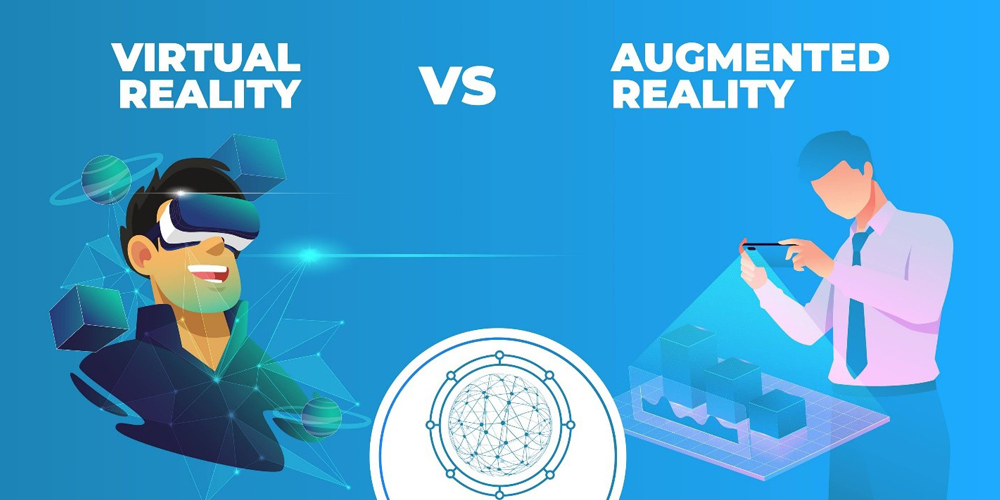The phrases "augmented reality" (AR) and "virtual reality" (VR) have gained popularity recently in the field of technical developments. These two innovations have completely changed how people engage with digital information and created an array of new opportunities across numerous industries. This article will examine the distinctions between virtual and augmented reality, as well as its unique uses, benefits, drawbacks, and potential future developments.
Introduction to Virtual Reality and Augmented Reality
User interaction with digital material can be achieved through two unique technologies: augmented reality and virtual reality. While virtual reality technology creates a fully immersive digital environment that resembles the real world, augmented reality technology overlays digital content on top of the real world.
What is Virtual Reality?
A technological advancement known as virtual reality produces a fully immersive digital environment that mimics the real world. This technology gives customers an entirely immersive experience through the use of specialized gadgets like head-mounted displays. Virtual reality has applications in a number of domains, including training, education, and gaming. It gives users the opportunity to experience things like flying, swimming, and visiting far-off worlds that are not feasible in reality.
The difference between Augmented Reality and Virtual Reality
The main difference between virtual and augmented reality is how each engages with the user. While virtual reality delivers an entirely immersive digital experience, augmented reality superimposes digital content on top of the physical world. While virtual reality necessitates specialized gadgets that totally block out the outside world, such head-mounted displays, augmented reality requires a device with a camera and sensors, like a smartphone or smart glasses.
The degree of immersion is another important distinction between virtual reality and augmented reality. Users can enjoy a partially immersive experience with augmented reality, where digital content is superimposed over the actual environment. On the other hand, users can fully immerse themselves in a digital environment using virtual reality, offering them an immersive experience.
Applications of Augmented Reality
There are numerous uses for augmented reality in diverse industries. Within the gaming sector, augmented reality offers a distinctive and engaging gaming experience by enabling gamers to interact with digital content in the real environment. In the classroom, augmented reality can be applied to give pupils a more dynamic and engaging method to interact with digital content. Augmented reality can be utilized in the retail sector to give clients a more customized shopping experience by letting them see things in real life.
Virtual Reality Applications
There are many uses for virtual reality in many different industries. Within the gaming sector, virtual reality offers players an entirely immersive experience that allows them to engage with digital content in a more lifelike manner. In addition to being utilized in training and education, virtual reality enables users to mimic real-world situations and study in a secure setting. Patients with phobias or anxiety disorders can be treated in the medical field by using virtual reality to expose them to surroundings that arouse their concerns.
Advantages and Disadvantages of Augmented Reality
Augmented reality presents a number of advantages as well as disadvantages. The ability to overlay digital content on top of the actual environment to enhance it and provide users a more interactive and engaging experience is one of augmented reality's key benefits. Users can also receive pertinent information from augmented reality depending on their surroundings and location. However, one of the primary drawbacks of augmented reality is the need for a camera- and sensor-equipped gadget, which can be costly and unavailable to everyone.
Advantages and Disadvantages of Virtual Reality
Virtual reality presents a range of advantages as well as disadvantages. One of the primary benefits of virtual reality is that it gives consumers an entirely immersive experience, enabling more realistic interactions with digital content. In addition to simulating real-world situations, virtual reality can offer users a secure and regulated learning environment. Nonetheless, a primary drawback of virtual reality is the need for specialized equipment, like head-mounted displays, which can be costly and unavailable to everyone.
Conclusion :
To sum up, there are two unique technologies—augmented reality and virtual reality—that let people engage with digital material in various ways. While virtual reality delivers an entirely immersive digital experience, augmented reality enriches the actual world by superimposing digital content on top of it. Both technologies have benefits and drawbacks of their own, and it is anticipated that they will be important in many other industries in the future. It will be interesting to watch how virtual reality and augmented reality affect how people interact with digital information as technology develops further.


